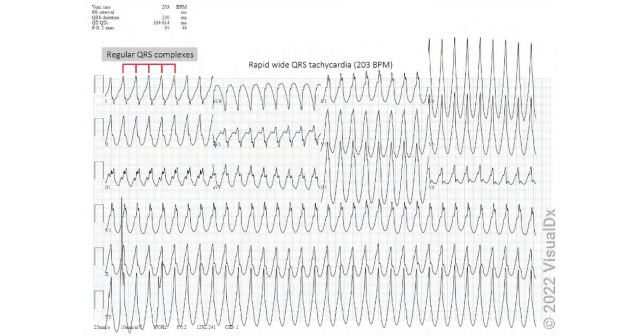
Answer: The correct answer is ventricular tachycardia (d).
Explore This Issue
ACEP Now: Vol 42 – No 07 – July 2023Ventricular tachycardia (VT) is more common in men and in individuals older than 65 years. The most common risk factors include structural heart disease (i.e., cardiomyopathies), and ion-channel mutations (i.e., catecholaminergic polymorphic VT). Idiopathic VT occurs in a structurally normal heart and is very rare.
Presentation varies from asymptomatic to pulseless cardiac arrest. Common presenting symptoms are weakness, dizziness, palpitations, chest pain, shortness of breath, syncope, sudden collapse, and cardiac arrest.
Treatment varies depending on the presenting symptoms and the patient‘s hemodynamic stability. For pulseless VT, cardiopulmonary resuscitation needs to be started immediately. Other treatments include electrical cardioversion and the use of antiarrhythmic drugs (e.g., amiodarone or lidocaine). Patients with a history of life-threatening or recurrent VT will often undergo radiofrequency catheter ablation and/or placement of a cardioverter defibrillator (implantable or external).
(See the original question here.)
Member Benefit: All ACEP members receive a 20 percent discount on VisualDX.
Reference
- Anjeza Cipi MD, et al. Ventricular tachycardia. Visualdx website. Updated 03/29/2023. Accessed June 16, 2023.





No Responses to “VisualDX Answer: d) Ventricular Tachycardia”